
How to choose and install water purification filters from well with their own hands Useful advice,Plot.
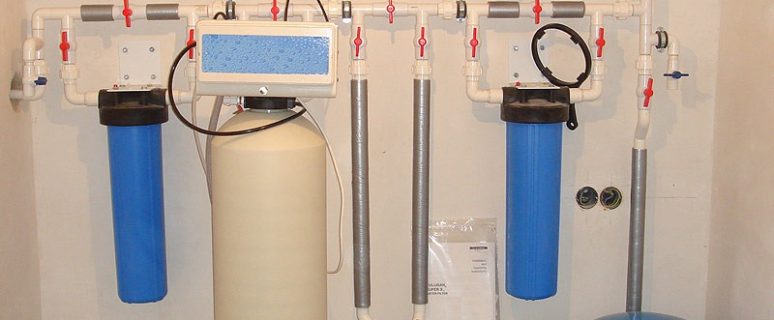
The problem of purification of water coming from the well always remains relevant. Water, for use in various domestic purposes and for drinking, must meet certain quality criteria. First of all, be safe to health and pleasant to taste. In the water systems, whole sellers were built, but if you do not use central water supply, but your own well, then you yourself will have to take care of the purity of the water used.
Content
What you need to know about water purification
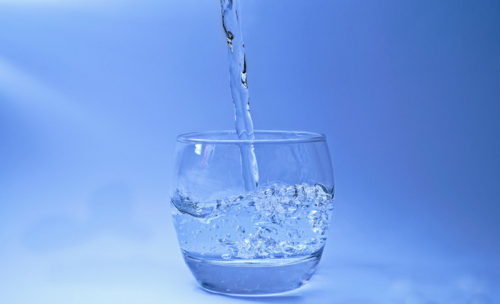
Not always water from wells complies with the requirements of quality. In 70% of cases, water from wells has an increased heavy metal content, such as iron, copper, manganese and zinc. In addition, rigid salts, nitrates and waste productions as industrial, so animals and agricultural and agricultural can be in water from wells. Therefore, the water entering the house from wells must be filtered.
The choice of filters for water purification from the well is not always a simple task. Not enough when choosing a filter is guided only by price and promotional information.
The result that needs to be obtained largely depends on the correctly selected water purification method. To do this, first obtain and analyze the following data:
- the composition of water, taking into account its seasonal changes in this area;
- the presence of harmful impurities in water and their forms;
- what are the technological characteristics of wastewater treatment systems, as far as they are reliable and what is their bacteriological resistance to the effects of harmful impurities in the presence of them in water;
- how much waste is obtained when water purified in one way or another, their composition and disposal technology;
- the cost of the entire water purification process;
- opportunities to repair the sewage system and the cost of its service.
Determination of the composition of water from the well

To determine the composition of water from the well, it must be properly taken on the sample and then transfer to the SES or other specialized organization analysis.
To take the water for sample, you must perform the following:
- Prepare the water taking capacity on the sample and thoroughly wash it.
- Fill the water into the tight-thin flowing of the vessel walls so that the water is unnecessarily saturated with oxygen in order to avoid the flow of additional chemical reactions.
- When water fills the tank to the throat, tightly and securely close it so as not to create an air traffic jam.
- If water is not immediately sent to the analysis, then place the container with water in the refrigerator no more than 48 hours.
- Before passing water to conduct an analysis, attach a note to the container. In the note, specify: the place of water take-off (address of the site with a borehole), the depth of the well and the date of the test of the sample.
Types and Water Cleaning Methods
Depending on the resulting result of analyzing the water taken from the well, it will be necessary to decide what to be removed from the water and how to do it.
To the main factors that worsen water quality and methods of removal are:
- Unsolved particles of suspension and colloidal substances. Remove with mechanical filters.
- "Irony" taste of water. Such a taste gives an increased iron content in water. Corrected by special filters for deferrization.
- Rigid water, which, due to the increased percent of the rigid salts of magnesium and calcium, creates a scale and white flare on the dishes and electrical appliances. This is fraught with the failure of heating elements in household appliances, as well as not very useful for health. For softening water, softeners are used. They replace calcium and magnesium ions on sodium ions.
- Unpleasant smell, taste and color. Remove with coal filters.
- Pollution of water with various bacteria. Cleansing is carried out using ultraviolet sterilizers, ozonizers or membrane filters.
Selection of water purification filters from well
In order to start the choice of necessary filters, it is necessary to figure out which they are on purpose, the technological characteristics of the filters, as far as they are reliable, what is the cost of cleaning the water and the cost of their maintenance.
Mechanical water purification filters

- Mechanical water purification filters belong to the coarse cleaning group or to the device of the first level of cleaning. At this stage, it is necessary to separate the dirt, sand and other suspended particles from the water. The presence of such impurities may fail to fail to work effectively to operate devices for subsequent purification of water and makes water unsuitable.
- The filters of this group are mesh, disk or flowing type. The selection of this or that type depends on the water used and prices on them. This cleaning step is usually on the immersion pump itself or at the end of the intake sleeve. Therefore, it must be taken into account already at the stage of selection of pumping equipment for the arrangement of the well. The presence of a mechanical filter on the submersible pump will save you from additional costs and the cleaning process will be easily.
- However, not all suspension are removed by the filter on the submersible pump. At this stage, water will be cleaned only from large particles of 300-500 microns in size, and smaller will remain. The size of the removable particles depends on the structure of the cleansing element. The smaller the sizes of the cells, the smaller particles are eliminated from the water. However, it increases the need for cleaning the filter element itself. The optimal solution here will be the installation of several filters with different degrees of cleaning with a gradual decrease in the diameter of the cells from 500 μm to 50 microns. Instead of several filters, a mechanical filter with a multi-layer filter loading from sand, fine coal, clamzit, etc. can be used. In multilayer filters, the main supporting layer is garnet with various composition. The distribution of particles of different weights by granulated load allows you to ensure high filtering rates and removing mechanical particles of various sizes, and also guarantee long-term operation.
Water Definkic Filters

Iron, which can be in water from the well, is bivalent and trivalent. The bivalent iron in the water is invisible, and its presence is detected only when the bivalent form goes into trivalent. Then the precipitate will appear in the form of rust. Therefore, the filters for the lettage of water work according to this principle - they translate iron from the bivalent to trivalent and remove it mechanically.
In order to select a filter removing iron, you need to consider:
- The amount of iron in the composition of water.
- The number of daily water consumed.
- Water pressure in the housewater system at home, and accordingly the type of pumping station.
- Opportunities for the placement of the filter in the place where its freezing protection is ensured.
- Opportunities of the sewer system using additional water reception when washing the filter.
- Features on the choice of price category.
Water Mitigation Filters
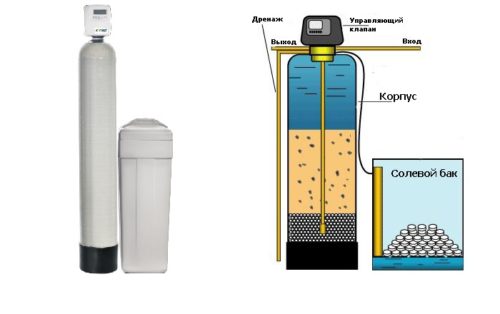
Filters softeners are a whole class of devices designed to reduce water rigidity. Such filters are comprehensive and can additionally remove iron, manganese, salts of heavy metals and organic compounds. In devices for mitigating water as a filter element, high-quality ion exchange resins are used. Such resins have a greater exchange capacity, and excellent mechanical characteristics provide a high resource of the operating resource with softeners.
The most practical and fairly effective are ion exchange filters that reduce the content of magnesium salts and calcium to 0.01 mg / l. These are trunk filters for water softening installed in the plumbing pipe of both hot and cold water. In addition, the filters softeners can be installed under the sink or in front of the household appliances.
Ion-exchange filters for water softening are the following types:
- In the form of a small amount of flasks. Apply for small volume of water. The main advantage is the low price.
- Compact devices with interchangeable cartridges that can be installed before washing or home appliances.
- Devices in the form of a cylinder with sodium crystals for a regenerative way of mitigation of water. One of the most effective quality and performance of filters, but has a high cost and is not recommended for the use of water in nutritional purposes.
In addition, there are filters of reverse osmosis and magnetic filters. However, the first have a high price, and the second require periodic cleaning from the slag of destroyed magnesium and calcium salts.
In any case, when choosing a softening filter water, it is necessary to consider:
- The amount of water used.
- The degree of water rigidity (average, tough, super heavy).
- The possibility of maintenance.
- The possibility of autonomous work without constant control.
- Opportunities of the sewer system according to additional water reception when resetting the saline.
- Electricity costs.
- Ability to choose from the price category.
Coal filters
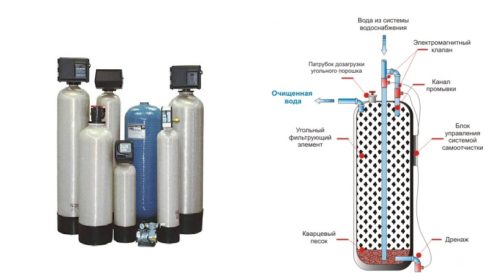
- In coal filters, activated carbon is used as a filter element. Activated carbon is a mixture of charcoal, coconut coal, oil coke and other different components of carbon containing.
- Coal filters belong to the thin cleaning group. The main purpose of the coal filter is the purification of water from impurities that attach an unpleasant taste, color and smell or improving organoleptic water indicators. All these impurities are removed from the water when it passes through the filter composition - sorbent (coal). Due to the high adsorption capacity of activated carbon, it effectively absorbs gases dissolved in water, organic compounds and chlorine.
- The optimal solution for water purification from the well for autonomous water supply is the automatic sewage system. It consists of a plastic container with a coal filtering element and additional blocks that provide automatic system operation.
When choosing and installing coal automatic water purification systems, it is necessary to consider:
- Water pressure in the housewater system at home, and accordingly the type of pumping station.
- Opportunities for the placement of the filter in the place where its freezing protection is ensured.
- It is impossible to place filters near the source of strong heat.
- Ability to ensure good ventilation of the location of the system.
- The possibility of maintenance (access to drainage).
- The location of coal filters in the cleansing system must be after the first coarse level, and the best at the final stage.
- Ability to choose from the price category.
Filters for removing bacteriological pollution of water
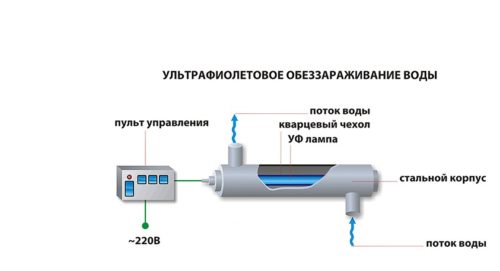
- For the purposes of water purification from heavy metal ions, bacteria and microorganisms, coal filters are used in combination with other sorbents. For example, the use of carbon fiber Aqualen is very effective. This sorbent, compared to activated carbon, has a large water treatment resource, kills bacteria and microorganisms, deprive them of the opportunity to multiply, and easily copes with other impurities. In addition, silver and iodine-containing resin are added in some cleaning systems for bacteriological water purification in activated carbon.
- Excellent quality When cleaning, water acquires in systems using a unique pentapure polyhedral resin, American development. This resin practically completely destroys harmful viruses, bacteria and parasites. When combined in the filter element, Pentapure resin and activated carbon, the high effect of water purification is obtained. In addition, the resin protects coal from the ingestion of cleaning waste, which prolongs the resource for cleaning the water of the coal element.
- There are filters of thin bacteriological cleaning with membrane elements of reverse osmotic purple drinking water (for example, OSMO series OSMONICS, INC. (USA)).
What to choose water purification filters from well
Thus, each point of cleaning performs its function. Therefore, to obtain high-quality purified water taken from the well, a multistage cleaning system is necessary. It is best to apply automatic stationary household systems with filters of various purposes, located sequentially in about the following order:
- First, the water from the well through coarse purification from dirt (to the size of the particles of no more than 50 microns) in the mechanical filter of the submersible pump enters the water supply.
- Further through the pre-cleaning filters (optimally two mechanical medium cleaning filters and two composite filters with activated carbon), spoke from mechanical particles up to 5 μm, chlorine and the bulk of impurities, water enters the block with a reverse osmosis membrane.
- In a block with a reverse osmosis membrane, water is exempt almost from all other harmful impurities.
- Ultraviolet sterilizer can be used at the end stage.

- Simple devices with a smaller number of filters are used. Not bad reviews have household water purifiers of the "Barrier In-Line" series C1 and C2 models. Such models are stationary installed before the water distribution point and are connected to the water supply through a special adapter with a locking valve. The shut-off valve is necessary in any water purification system, as it allows, if necessary in maintenance, disconnect from the water supply.
- You can also advise various cleaning devices using electrical and electrochemical processes. For example, the filters of the Emerald brand toxic impurities are destroyed by electrochemical oxidation.
- In the systems of the brand "Crystal", bacteria and microbes are neutralized with ultraviolet radiation, and in the RBM instrument, water passes magnetic purification.
- Modern firms specializing in the manufacture of water purification filters offer consumer portable ion-type settings that allow high quality water at home. For water purification in living conditions, ozone is used, generated by electric discharges. So the firm "Ozone Technologies" produces well-proven household clearative systems "Aquamam". The effect of this water purification plant is based on ozone ability to disinfect water, destroying bacteria, viruses and other microorganisms, in addition, to translate some organic compounds and metal ions into water insoluble in water.
- The Aquamama device is three elements: a mechanical filter, a sorption unit with activated carbon and ozonizer. Such a device is connected to a plumbing system through a special adapter. In the ozonator housing there is a device for developing ozone and sound, as well as light indicators that signal the residue of the filter-cartridge resources. The automatic mode of operation of the water purifier "Aquamam" is provided by a vacuum relay that supports water consumption in the range of 1.5-3 l / min. The installation is mounted before the water distribution point and connects to the power grid, with a voltage of 220 V, through a household outlet. It has a low price, a relatively good reserve of resources (up to 30,000 liters) and a small power consumed not higher than 7W.
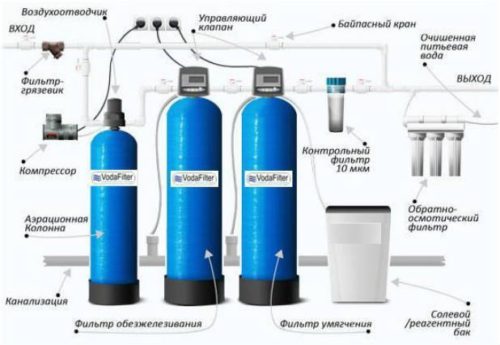
Installation of water purification filters from well
General rules
Each water purification device is accompanied by instructions on their installation and operation. In order for water to be cleaned in these filters, the required quality was obtained and maintained at this level, and the entire system remained working for a long time, it is necessary to follow certain rules stipulated by manufacturers of water purification devices. These basic rules include:
- Flowing filters (no dependence on the cleaning principle) must always be mounted using the regulator of the prescribed water consumption.
- Not allowing the pressure of water in the plumbing network is greater than the maximum permissible for each device (are adjusted by special devices mounted before the corresponding filter system).
- Replacing cartridges should be carried out in strictly installed resource parameters, otherwise the water passing through the filter will not be cleaned.
- When replacing the cartridges strictly observe the order of their placement inside the filter housing, so as not to confuse the corresponding housing (different destination cartridges may be the same appearance and size).
- To protect the water supply system, the pumping station and the water purification system from the hydrotarians, it is desirable to install a hydroaccumulator.
- Connect the water treatment system is necessary after the hydroaccumulator and automatics of the pumping station regulating operation (pump).
- To avoid the output of the pump, when clogged filters, it is necessary to regularly monitor the status of the filter elements (before each start of the pumping station) and to replace them in a timely manner. In addition, when the water purifier filters are arranged before automatics of adjusting the pump operation, you must install the switching pump with an increase in the water pressure value in the system above the critical (due to the clogging of filters).
- All electrical equipment must be connected in compliance with electrical safety measures with a preliminary ground.
- Pipelines must be placed in such a way as to ensure the possibility of repairing them (10-15 mm from the walls), and flexible hoses fix clamps and fixed on stationary equipment.
- To install filtering devices, it is necessary to provide and prepare a suitable place to accommodate them.
Procedure for installing water purification filters
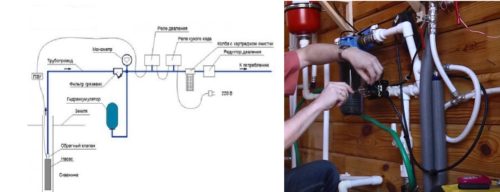
When installing water purification devices, you must follow the following procedure:
- Before starting the process of installing filters, prepare all the necessary equipment, tools and carefully examine the procedure.
- Make a common scheme of water filtration system from a well.
- All elements of the system decompose in a suitable place according to the scheme.
- Fasten the wall location in its locations using the accompanying devices, brackets or in another way.
- Connect all elements (valves, relays, pressure gauges, etc.) according to the scheme.
- Install the elements connected to the pipelines to the device fixed on the wall.
- Connect all drainages and drainage devices to a common sewage.
- Connect electrical equipment to the network.
- Connect the collected system to the plumbing network.
- Open all bumping cranes and start the water into the water purification system.
- Check the tightness of the assembled system and the reliability of fasteners.
- If there are leaks or other flaws, then break the water supply to the water purification system, drain all the water from the system and eliminate the shortcomings.
Selection and order of installing water purification filters from well video


















